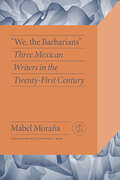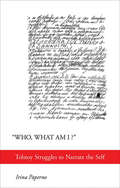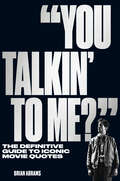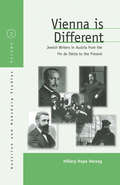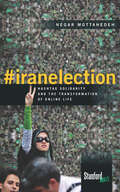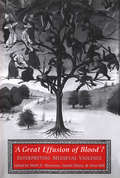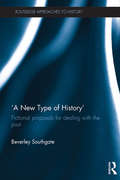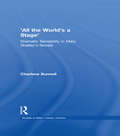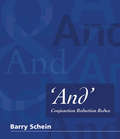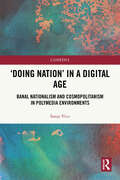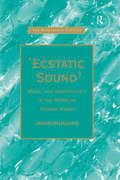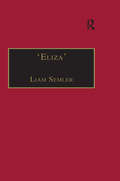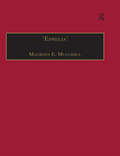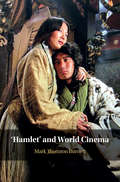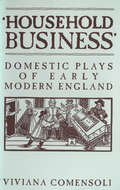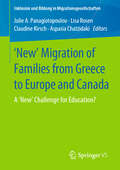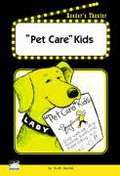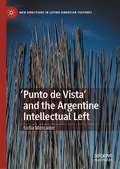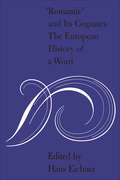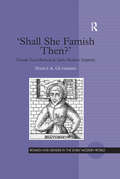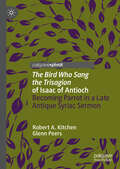- Table View
- List View
"We, the Barbarians": Three Mexican Writers in the Twenty-First Century (Critical Mexican Studies)
by Mabel Moraña&“We, the Barbarians&” embarks on a careful and exhaustive reading of three of the most prominent authors in the latest wave of Mexican fiction: Yuri Herrera, Fernanda Melchor, and Valeria Luiselli. Originally published in Mexico in 2021, this work is divided into three parts, one for each author&’s narrative production. The book analyzes all of the literary works published by Herrera, Melchor, and Luiselli from the beginning of their writing careers until 2021, allowing for a diachronic interpretation of their respective narrative projects as well as for comparative approaches to their aesthetic and ideological contours. Characterized by the fragmentation of civil society and the decomposition of the myths that accompanied the consolidation of the modern nation, Mexican visual and literary arts have explored a myriad of representational avenues to approach the phenomena of violence, institutional decay, and political instability. The critical and theoretical approaches in &“We, the Barbarians&” explore a variety of alternative symbolic representations of topics such as nationalism, community, and affect in times impacted by systemic violence, precariousness, and radical inequality. Moraña perceives the negotiations between regional/local imaginaries and global scenarios characterized by the devaluation and resignification of life, both at individual and collective levels. Though it uses three authors as its focus, this book seeks to more broadly theorize the question of the relationship between literature and the social in the twenty-first century.
"Who, What Am I?": Tolstoy Struggles to Narrate the Self
by Irina Paperno"God only knows how many diverse, captivating impressions and thoughts evoked by these impressions . . . pass in a single day. If it were only possible to render them in such a way that I could easily read myself and that others could read me as I do. . ." Such was the desire of the young Tolstoy. Although he knew that this narrative utopia—turning the totality of his life into a book—would remain unfulfilled, Tolstoy would spend the rest of his life attempting to achieve it. "Who, What Am I?" is an account of Tolstoy's lifelong attempt to find adequate ways to represent the self, to probe its limits and, ultimately, to arrive at an identity not based on the bodily self and its accumulated life experience. This book guides readers through the voluminous, highly personal nonfiction writings that Tolstoy produced from the 1850s until his death in 1910. The variety of these texts is enormous, including diaries, religious tracts, personal confessions, letters, autobiographical fragments, and the meticulous accounts of dreams. For Tolstoy, inherent in the structure of the narrative form was a conception of life that accorded linear temporal order a predominant role, and this implied finitude. He refused to accept that human life stopped with death and that the self was limited to what could be remembered and told. In short, his was a philosophical and religious quest, and he followed in the footsteps of many, from Plato and Augustine to Rousseau and Schopenhauer. In reconstructing Tolstoy's struggles, this book reflects on the problems of self and narrative as well as provides an intellectual and psychological biography of the writer.
"You Talkin' to Me?": The Definitive Guide to Iconic Movie Quotes
by Brian AbramsThis deep dive into hundreds of Hollywood&’s most iconic and beloved lines is a must-have for every film buff."You Talkin&’ to Me?" is a fun, fascinating, and exhaustively reported look at all the iconic Hollywood movie quotes we know and love, from Casablanca to Dirty Harry and The Godfather to Mean Girls. Drawing on interviews, archival sleuthing, and behind-the-scenes details, the book examines the origins and deeper meanings of hundreds of film lines: how they&’ve impacted, shaped, and reverberated through the culture, defined eras in Hollywood, and become cemented in the modern lexicon. Packed with film stills, sidebars, lists, and other fun detours throughout movie history, the book covers all genres and a diverse range of directors, writers, and audiences.
"vienna Is Different"
by Hillary HopeAssessing the impact of fin-de-siècle Jewish culture on subsequent developments in literature and culture, this book is the first to consider the historical trajectory of Austrian-Jewish writing across the 20th century. It examines how Vienna, the city that stood at the center of Jewish life in the Austrian Empire and later the Austrian nation, assumed a special significance in the imaginations of Jewish writers as a space and an idea. The author focuses on the special relationship between Austrian-Jewish writers and the city to reveal a century-long pattern of living in tension with the city, experiencing simultaneously acceptance and exclusion, feeling "unheimlich heimisch" (eerily at home) in Vienna.
#WeRateDogs: The Most Hilarious and Adorable Pups You've Ever Seen
by Matt NelsonThe ultimate book for our obsession with dogs on social media!“Over-the-top and hilarious.” —Barkpost <P><P>Based on the Twitter and Instagram sensation, #WeRateDogs features the most heroic, over-the-top adorable, wildly successful, all-around entertaining dogs the world has ever seen! It combines extraordinary photos with ridiculous captions to expand the knowledge and overall lives of its readers. It is not only an exceptionally reliable source for dog greatness, it is also a one stop shop for happiness. <P><P>This book takes readers on a journey through the strict science of dog rating and the unwavering rules associated with it. Questioning the accuracy of these ratings is ill-advised. They are certainly not arbitrary and this book is absolutely not just about how cute dogs are. It truly is all about precision and ethics in dog rating. <P><P>The #WeRateDogs book will produce an audible reaction with every flip of the page—whether a groan from a terrible pupper pun or an “aww” of seeing a super floofer. If #WeRateDogs takes you away from reality and pushes you into this conglomerate of absurdity for even a second, then it has fulfilled its purpose.
#iranelection: Hashtag Solidarity and the Transformation of Online Life
by Negar MottahedehThe protests following Iran's fraudulent 2009 Presidential election took the world by storm. As the Green Revolution gained protestors in the Iranian streets, #iranelection became the first long-trending international hashtag. Texts, images, videos, audio recordings, and links connected protestors on the ground and netizens online, all simultaneously transmitting and living a shared international experience. #iranelection follows the protest movement, on the ground and online, to investigate how emerging social media platforms developed international solidarity. The 2009 protests in Iran were the first revolts to be catapulted onto the global stage by social media, just as the 1979 Iranian Revolution was agitated by cassette tapes. And as the world turned to social media platforms to understand the events on the ground, social media platforms also adapted and developed to accommodate this global activism. Provocative and eye-opening, #iranelection reveals the new online ecology of social protest and offers a prehistory, of sorts, of the uses of hashtags and trending topics, selfies and avatar activism, and citizen journalism and YouTube mashups.
$ix-Figure Freelancing: The Writer's Guide to Making More Money
by Kelly James-EngerIs it possible to give up your nine to five job and make more money as a full-time freelancer? Absolutely. Six-Figure Freelancing shows writers how to make the most of the ballooning freelance industry by adopting a business-like approach to their craft, while offering insightful, first-hand advice to help maximize time and profit.* Includes worksheets and templates to assess and establish the best possible business strategy* Advice on time management and repurposing material for multiple markets, as well as how to gain a competitive edge in a growing marketFrom the Trade Paperback edition.
'A Great Effusion of Blood'?
by Oren Falk Mark D. Meyerson Daniel Thiery'A great effusion of blood' was a phrase used frequently throughout medieval Europe as shorthand to describe the effects of immoderate interpersonal violence. Yet the ambiguity of this phrase poses numerous problems for modern readers and scholars in interpreting violence in medieval society and culture and its effect on medieval people. Understanding medieval violence is made even more complex by the multiplicity of views that need to be reconciled: those of modern scholars regarding the psychology and comportment of medieval people, those of the medieval persons themselves as perpetrators or victims of violence, those of medieval writers describing the acts, and those of medieval readers, the audience for these accounts. Using historical records, artistic representation, and theoretical articulation, the contributors to this volume attempt to bring together these views and fashion a comprehensive understanding of medieval conceptions of violence.Exploring the issue from both historical and literary perspectives, the contributors examine violence in a broad variety of genres, places, and times, such as the Late Antique lives of the martyrs, Islamic historiography, Anglo-Saxon poetry and Norse sagas, canon law and chronicles, English and Scottish ballads, the criminal records of fifteenth-century Spain, and more. Taken together, the essays offer fresh ways of analysing medieval violence and its representations, and bring us closer to an understanding of how it was experienced by the people who lived it.
'A New Type of History': Fictional Proposals for dealing with the Past (Routledge Approaches to History)
by Beverley SouthgateLinking fiction with history and historical theory, 'A New Type of History': Fictional Proposals for dealing with the Past focuses on a selection of nineteenth- and twentieth-century novelists – Tolstoy, Proust, John Cowper Powys, Virginia Woolf, Wyndham Lewis, Penelope Lively, and James Hamilton-Paterson – who have criticized scientifically based history and proposed alternative ways of approaching the past: more subjective and personal, colourful and imaginative, and above all ethically orientated. In this, it is argued, they have been reverting to an earlier rhetorical model for history, which is now being increasingly adopted by practising historians. This ‘new type of history’ may lack the claimed ‘objectivity’ and ‘truth’ of its immediate predecessor, but it opens the way for an ethically focused subject that may be used (in Nietzsche’s words) ‘for the purpose of life’. Providing a new take on both novelists and historiography, and ranging widely from the nineteenth century to the present day, this cross-disciplinary study will be valuable reading for all those interested in the intersection and interplay between fiction and history.
'All the World's a Stage': Dramatic Sensibility in Mary Shelley's Novels (Studies in Major Literary Authors)
by Charlene BunnellThis book examines the often tragic and nearly always disabling metaphor of thetheatrum mundi, world-as-stage, as it plays itself out in the characters of Mary Shelley's novels.
'And': Conjunction Reduction Redux (The\mit Press Ser.)
by Barry ScheinA bold argument that “and” always means “&,” the truth-functional sentential connective.In this book, Barry Schein argues that “and” is always the sentential logical connective with the same, one, meaning. “And” always means “&,” across the varied constructions in which it is tokened in natural language. Schein examines the constructions that challenge his thesis, and shows that the objections disappear when these constructions are translated into Eventish, a neo-Davidsonian event semantics, and, enlarged with Cinerama Semantics, a vocabulary for spatial orientation and navigation. Besides rescuing “and” from ambiguity, Eventish and Cinerama Semantics solve general puzzles of grammar and meaning unrelated to conjunction, revealing the book's central thesis in the process: aspects of meaning mistakenly attributed to “and” are discovered to reflect neighboring structures previously unseen and unacknowledged.Schein argues that Eventish and Cinerama Semantics offer a fundamental revision to clause structure and what aspects of meaning are represented therein. Eventish is distinguished by four features: supermonadicity, which enlarges verbal decomposition so that every argument relates to its own event; descriptive event anaphora, which replaces simple event variables with silent descriptive pronouns; adverbialization, which interposes adverbials derived from the descriptive content of every DP; and AdrPs, which replace all NPs with Address Phrases that locate what nominals denote within scenes or frames of reference.With 'And,' Schein rehabilitates an old rule of transformational, generative grammar, answering the challenges to it exhaustively and meticulously.
'Doing Nation' in a Digital Age: Banal Nationalism and Cosmopolitanism in Polymedia Environments (Comedia)
by Sanja VicoThis book introduces a new theory of national identity, arguing that the nation does not only represent an abstract “imagined community” but also represents embodied cultural and discursive practices.Drawing upon a detailed case study of Serbian Londoners, this truly interdisciplinary study positions media as constitutive of national identities. The author contends that nations come into being and are sustained through everyday interpersonal communication practices that have increasingly become mediated, especially for migrants. She develops the concept of "doing nation" to argue that we should think of the nation as a dynamic process. Situated first within a particular migration context, the concept is then applied more broadly as everyday communication practices are becoming increasingly mediated worldwide.Covering a breadth of key theories and concepts in this field, including diaspora, ethnicity, nationalism, cosmopolitanism, social media affordances and polymedia, this book will appeal to scholars and students researching digital media, migration, identities, nationalism and cosmopolitanism in the social science disciplines.
'Ecstatic Sound': Music and Individuality in the Work of Thomas Hardy (The Nineteenth Century Series)
by John HughesThis book studies the ways Hardy writes about music, and argues that this focus allows for a close and varied investigation of the affective dimensions of his poetry and fiction, and his recurrent preoccupations with time, community and love. Throughout his work Hardy associates music with moments of individual expression and relatedness. For him, music provokes a response to life that is inseparable from what gives life value, as well as being incompatible with his increasingly conscious vision of personal and social limitation. The first two chapters trace how this ironic disjunction is evident in the novels and the tales, while exploring in detail how they represent and evoke the spiritual and emotional transports of musical experience. In a corresponding way, the third and fourth chapters concentrate on how, within the poetry, music works as a vehicle of inspiration and memory, recurrently surprising the conscious self with intimations of other potentials of expression. In the fifth chapter, the focus falls on Hardy's own philosophical reading, and thus on his notebooks and letters, so as to revisit in an altered context many of the issues that have been opened up by the book's emphasis on his literary representations of musical experience-issues of individuality, of unconscious and bodily experience, of literary language. Finally, although the book does incorporate some biographical detail about Thomas Hardy's lifelong passion for playing and collecting music, it predominantly works through close reading, while also drawing at points on literary theoretical texts, where these offer ways of articulating the broad questions of literary convention and representation that arise.
'Eliza': Printed Writings 1641–1700: Series II, Part Two, Volume 3 (The Early Modern Englishwoman: A Facsimile Library of Essential Works & Printed Writings, 1641-1700: Series II, Part Two)
by Liam SemlerThis facsimile edition reproduces the work titled Eliza's Babes which was first published in 1652. The volume comprises devotional and political verse and prose meditations. The poems cover a wide range of forms from verse epistles to poetic petitions, religious love lyrics to poems on earthly marriage, exultant poetic prayers to stern spiritual admonitions. The meditations are fine examples of the Puritan believer's plain-style response to various biblical texts, theological issues and political events. The text is historically and aesthetically unique. It reveals its anonymous author to be perhaps the first woman to publish substantial creative imitations of poems printed in George Herbert's The Temple (1633) and to rely upon and respond to Robert Herrick's Hesperides (1648). Eliza's Babes is a literary work of great originality. The narrator lives out her estate of salvation as an almost literally experienced marriage of election to Christ her Saviour. In a series of poems, 'Eliza' overcomes her initial shock and disappointment that her heavenly spouse has chosen an earthly partner for her, though this partner's prerogative is noticeably confined to the subservient role of facilitating his wife's heavenly marriage. The copy reproduced in this edition is the British Library text.
'Ephelia': Printed Writings 1641–1700: Series II, Part Two, Volume 8 (The Early Modern Englishwoman: A Facsimile Library of Essential Works & Printed Writings, 1641-1700: Series II, Part Two)
by Maureen E. MulvihillThis facsimile edition reproduces the extant works of the seventeenth-century poet, 'Ephelia'. By tradition, the identity of 'Ephelia' has been a long-contested debate in English letters. In her extended Introductory Note, Maureen Mulvihill culls evidence from the 'Ephelia' texts and from contemporary sources to show that the most likely candidate is Mary Villiers, later Stuart, Duchess of Richmond and Lennox (1622-1685). The volume opens with the reproduction of A Poem To His Sacred Majesty, On the Plot... (1678) from the copy held at the Bodleian Library. This is a large broadsheet poem prompted by The Popish Plot, expressing support for King Charles II. A new addition to the corpus of 'Ephelia's work is a variant of this 1678 parent-text, displaying a woodcut printer's ornament (factotum, with inset typepiece 'H'), which may hold special significance. This volume reproduces the copy preserved at the Huntington Library, and supplies with the facsimile an enlarged image of the ornament. Female Poems on several Occasions (1679) offers a rich variety of material: political verse, excerpted material from the poet's 'lost' play, love poetry and coterie verse critical of the moral decline of the Stuart court. The copy of the book reproduced here is that preserved at the Folger Shakespeare Library. The final printed work in the volume is Advice To His Grace ([1681]) in which 'Ephelia' admonishes the Duke of Monmouth and advocates the purity of the Stuart line and the integrity of the Stuart succession. The copy reproduced here is preserved at the Beinecke Library. The volume concludes with three appendices: two Van Dyck portraits of Lady Mary Villiers; a signed manuscript elegy, preserved at Nottingham, with an enlarged image of its armorial watermark; and the title-page of the poet's Female Poems (1682).
'Hamlet' and World Cinema
by Mark Thornton Burnett'Hamlet' and World Cinema reveals a rich history of cinematic production extending across the globe. Making a case for Hamlet as the world's most frequently filmed text, and using specially commissioned interviews with cast, directors and screenwriters, it discusses films from Africa, Asia, Europe, Latin America and the Middle East. The book argues that the play has been taken up by filmmakers world-wide to allegorise the energies, instabilities, traumas and expectations that have defined the twentieth and twenty-first centuries. In so doing, it rejects the Anglophone focus which has dominated criticism up to now and explores instead the multiple constituencies that have claimed Shakespeare's most celebrated work as their own. 'Hamlet' and World Cinema uncovers a vital part of the adaptation story. This book facilitates a fresh understanding of Shakespeare's cinematic significance and newly highlights Hamlet's political and aesthetic instrumentality in a vast range of local and global contexts.
'Household Business'
by Viviana ComensoliThe domestic play flourished on the English popular stage during the late sixteenth and early seventeenth centuries. Its roots were predominantly native, rather than classical, and its mainspring was the staging of domestic conflict amongst English characters from the middle ranks of society. Household Business traces the genre's origins in the cycle plays of medieval England and examines its aesthetic configurations in relation to extra-literary discourses and practices that underwrote Renaissance ideologies of private life. At a time when the orthodox view of the family defined it as the foundation of the social order, a number of domestic dramas took a more critical perspective, stressing the contradictions and struggles that attend marriage and the patriarchal family.In addition to well-known domestic dramas as A Woman Killed with Kindness, Arden of Feversham, The Witch of Edmonton, and A Yorkshire Tragedy, Viviana Comensoli analyzes less well-studied plays as A Warning for Fair Women, Two Lamentable Tragedies, and The Late Lancashire Witches. The book also provides an extensive and timely assessment of domestic comedy, demonstrating how plays such as The London Prodigal, The Fair Maid of Bristow, and The Honest Whore (Parts I and II) resist homiletic paradigms in favour of a more dialectical dramaturgy.
'Lector Ludens'
by Michael SchamIn sixteenth- and seventeenth-century Spain, debating the acceptability of games and recreation was serious business. With Lector Ludens, Michael Scham uses Cervantes's Don Quijote and Novelas ejemplares as the basis for a wide-ranging exploration of early modern Spanish views on recreations ranging from cards and dice to hunting, attending the theater, and reading fiction.Shifting fluidly between modern theories of play, little-known Spanish treatises on leisure and games, and the evidence in Cervantes's own works, Scham illuminates Cervantes's intense fascination with games, play, and leisure, as well as the tensions in early modern Spain between the stern moralizing of the Counter-Reformation and the playfulness of Renaissance humanism.
'New' Migration of Families from Greece to Europe and Canada: A 'New' Challenge for Education? (Inklusion und Bildung in Migrationsgesellschaften)
by Lisa Rosen Julie A. Panagiotopoulou Claudine Kirsch Aspasia ChatzidakiThe volume aims at analysing the migration processes of families from Greece following the financial crisis from 2009 onwards. It investigates whether and to what extent this ‘new’ and international migration represents a new phenomenon when compared to the so-called migration of guest-workers during the sixties.
'Pet Care' Kids
by Jackie Urbanovic Pam Hirschfeld Ruth RomerPerform this script about two kids who set up a pet care business to save money to buy a dog.
'Punto de Vista' and the Argentine Intellectual Left (New Directions in Latino American Cultures)
by Sofía MercaderThis book is the first comprehensive account of the Argentine magazine Punto de Vista (1978–2008), a cultural review that gathered together prominent Argentine intellectuals throughout the last quarter of the twentieth century. Directed by cultural historian and public intellectual Beatriz Sarlo, the story of the magazine serves as a lens to study the evolution of Argentine intellectuals from the leftist mobilization of the 1960s through periods of military dictatorship and then the shifting politics of democratization in the 1980s and 1990s. The book argues that the way in which the Argentine intellectual left negotiated the political and cultural transformations of the late twentieth century can be understood as the history of two political defeats: that of the revolutionary utopias of the 1960s and 1970s and that of the social democrat project in the 1980s. By adopting an interdisciplinary approach, this book encompasses a wide range of debates taking place in Argentina, from the years prior to the dictatorship to the postdictatorship period.
'Romantic' and Its Cognates: The European History of a Word
by Hans EichnerEver since the word romantic and its many cognates in European languages began to be used as technical terms towards the end of the eighteenth century, the quest for a satisfactory definition of their meanings has continued unabated. This collection of essays traces the history of the word in the major European languages, showing how romantic and its cognates were first introduced, how their usage spread and their connotations proliferated, and how their present usage became established. This book opens with an introduction by the editor, followed by an essay in which Professor Raymond Immerwaher, Chairman of the Department of German, University of Western Ontario, shows how romantic and its cognates became fashionable in England, France and Germany, and traces the extension of the meanings of these words up to 1790. The story is then taken up in individual essays on the history of the word and its cognates in the major European countries: in Germany, by the editor; in England, by Professor George Whalley, FRSC, of the Department of English, Queen's University, Kingston; in France, by Professor Maurice Z. Shroder of the Department of French, Barnard College, Columbia University; in Italy, by Professor Olga Ragusa of the Department of Italian, Columbia University; in Spain, by Professor Donald L. Shaw of the Department of Hispanic Studies, University of Edinburgh; in Scandinavia, by Professor P.M. Mitchell of the Department of Germanic Languages and Literature, University of Illinois; and in Russia, by Professor Sigrid McLaughlin of the Department of Slavic Studies, University of California at Santa Cruz. The final essay, by H.H.H. Remak, Professor of German and Comparative Literature at the University of Indiana, reports on trends of recent research on West European romanticism and suggests fruitful avenues for further exploration. The book will be of immense value to students and specialists interested in literary, linguistic and cultural aspects of romanticism, and to those concerned with comparative literature and the history of ideas. Hans Eicner taught at Queen's University, Kingston, from 1950 to 1967 when he was appointed Professor and Chairman of German, University of Toronto. Among his published books are: Thomas Mann, Eine Einführung in sein Werk; Friedrich Schlegel: Literary Notebooks 1797-1801; Reading German for Scientists; Kritische Friedrich Schlegel-Ausgabe (in four volumes); Four Modern German Authors: Mann, Rilke, Kafka, Brecht. In 1967 he was elected a Fellow of the Royal Society of Canada.
'Shall She Famish Then?': Female Food Refusal in Early Modern England (Women and Gender in the Early Modern World)
by Nancy A. GutierrezNancy Gutierrez's exploration of female food refusal during the early modern period contributes to the ongoing conversation about female subjectivity and agency in a number of ways. She joins such scholars as Gail Kern Paster, Jonathan Sawday, and Michael Schoenfeldt, who locate early modern ideas of selfhood in the age's understanding of the body and bodily functions, that is, the recognition that behavior and feelings are a result of the internal workings of the body. Exploring the portrayals of the anorectic woman in the work of Ford, Shakespeare, Heywood and others and arguing that the survival of these women undermines regulatory policies exercised over them by those in authority, Gutierrez here demonstrates how female food refusal is a unique demonstration of individuality. The chapters of this book reveal how the common cultural association of women and food manifests itself in the early modern period-not as religious expression, which is the medieval representation, and not as an expression of dysfunctional adolescence and maturation, our own contemporary view, but rather as a trope in which the female body is a site of political apprehension and cultural change. This study is neither a history nor a survey of the anorectic female body in early modern England, but rather individual yet related discussions in which the starved female body is seen to signify certain (un)expressed tensions within the culture.
'The Bird Who Sang the Trisagion' of Isaac of Antioch: Becoming Parrot in a Late Antique Syriac Sermon (Palgrave Studies in Animals and Literature)
by Glenn Peers Robert A. KitchenThis book provides close historical, theological and cultural analyses of an important, but neglected, Late Antique writer, Isaac of Antioch, who was active during the second half of the fifth century. This book is the first English-language monograph on this key figure and also includes the first translation (without the Syriac) of this compelling metrical homily into English, which has at its heart the public pronouncement by a parrot of theological truths. The authors situate this remarkable text in the wider fields of performance studies, animal studies and media studies, all areas that can illuminate essential meanings and implications of the homily.
'The Damned Fraternitie': Constructing Gypsy Identity in Early Modern England, 1500–1700
by Frances Timbers'The Damned Fraternitie': Constructing Gypsy Identity in Early Modern England, 1500–1700 examines the construction of gypsy identity in England between the early sixteenth century and the end of the seventeenth century. Drawing upon previous historiography, a wealth of printed primary sources (including government documents, pamphlets, rogue literature, and plays), and archival material (quarter sessions and assize cases, parish records and constables's accounts), the book argues that the construction of gypsy identity was part of a wider discourse concerning the increasing vagabond population, and was further informed by the religious reformations and political insecurities of the time. The developing narrative of a fraternity of dangerous vagrants resulted in the gypsy population being designated as a special category of rogues and vagabonds by both the state and popular culture. The alleged Egyptian origin of the group and the practice of fortune-telling by palmistry contributed elements of the exotic, which contributed to the concept of the mysterious alien. However, as this book reveals, a close examination of the first gypsies that are known by name shows that they were more likely Scottish and English vagrants, employing the ambiguous and mysterious reputation of the newly emerging category of gypsy. This challenges the theory that sixteenth-century gypsies were migrants from India and/or early predecessors to the later Roma population, as proposed by nineteenth-century gypsiologists. The book argues that the fluid identity of gypsies, whose origins and ethnicity were (and still are) ambiguous, allowed for the group to become a prime candidate for the 'other', thus a useful tool for reinforcing the parameters of orthodox social behaviour.
